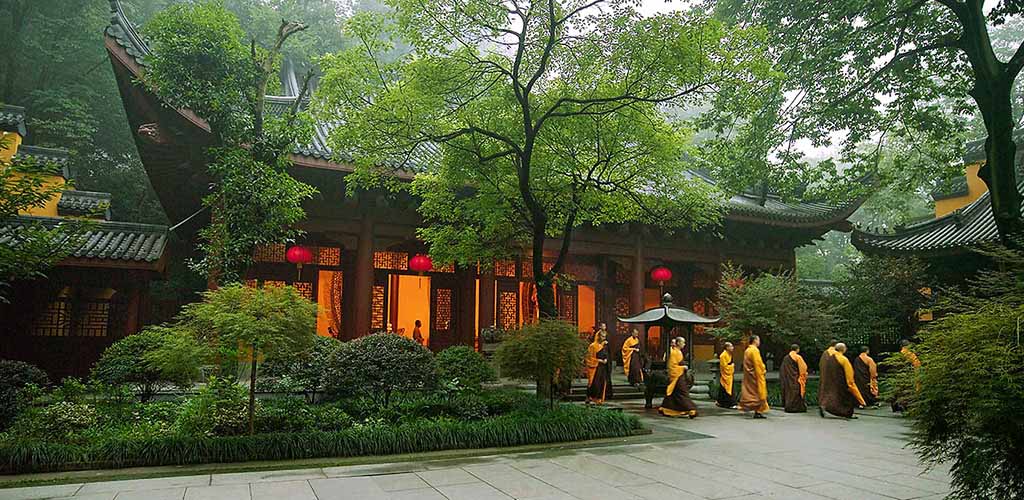Hangzhou
Given its location just 75 miles southwest of Shanghai, the epicenter of China’s recent economic boom, it is a place where the old and the new Chinas currently strive to coexist. Hangzhou has always been a prosperous city, thanks to its location at the southern end of the 1,100- mile-long Grand Canal and a terminus of the Silk Road, linking classical China with the ports of the eastern Mediterranean. Hangzhou, of course, is most known for the famed tea it produces, Dragon Well, a variety of pan-roasted green tea from the area of Longjing Village. Produced mostly by hand, it has always been renowned for its high quality and in history, granted the status of Gong Cha, or imperial tea, in the Qing dynasty by the Kangxi Emperor.
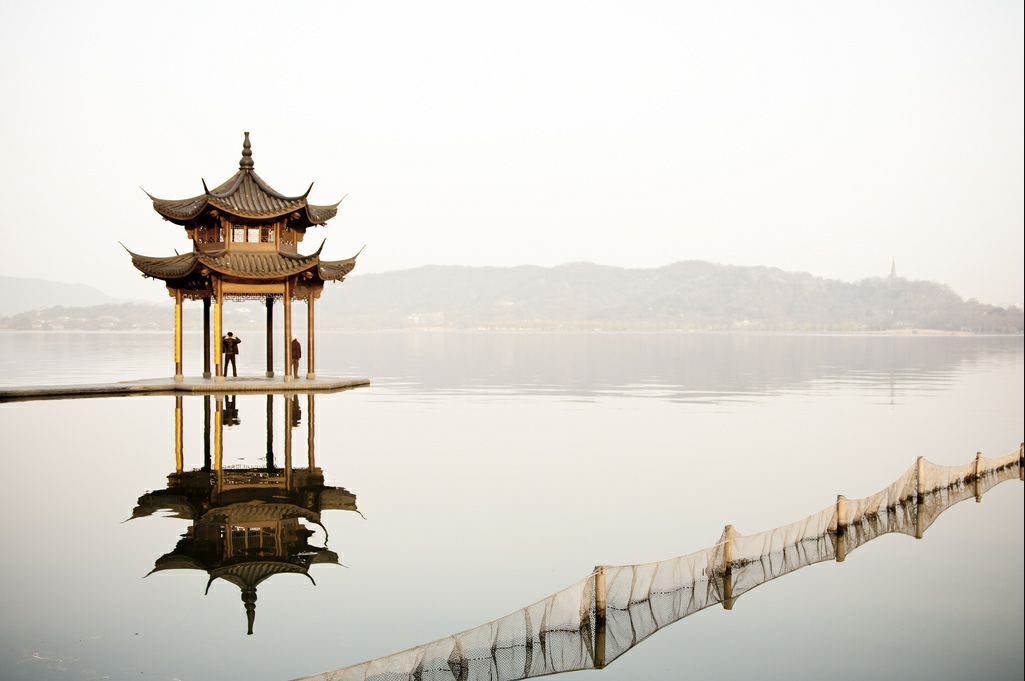
These days, however, the city enjoys a reputation as the most affluent in the entire country, where the newly wealthy of Shanghai buy hillside properties overlooking the celebrated West Lake, a combination of mountains and water which, like The Peak in Hong Kong, is said to possess especially potent feng shui, or mysteriously auspicious power. Hangzhou now possesses a population of more than 6 million, but despite its growing size, districts bordering the lake remain pretty, tranquil and clean. It is possible to walk, jog or cycle around much of the shoreline, pausing on the willow-shaded paths to gaze out across the expanse of glassy water. Aside from the lake, Hangzhou offers a number of fascinating monuments including the enormous 4th-century Lingyin Si Buddhist temple and the magnificent 10th-century Six Harmonies Pagoda.
Hangzhou Suggested Itinerary
In the early hours of the morning we will head out to visit the parks around West Lake, spying locals who can still be seen engaging in traditional arts, drawing calligraphy on the walkways with water, or practicing Taichi or Qi Gong. After witnessing the misty early-morning scene on the lake, taking a short cruise by private boat to the islets and two particularly lovely spots: Viewing Fish at Flower Pond (near Nanshan Road, on the south side of the lake), an 800-year-old garden famous for its peonies and carp pond, and Guo’s Villa, an early 20th century family compound built in the style of a classical garden.
After returning, visting Lingying Temple, believed to be the oldest Buddhist temple in the city which has gone through numerous cycles of destruction and reconstruction. The picturesque monastery is the largest of several temples in the Wulin Mountains, which also features a large number of grottoes and religious rock carvings, the most famous of which is the Feilai Feng (飞来峰; literally "the peak that flew hither").
Lingying Temple is also major pilgrimage spot and the crowds are fascinating, with crimson- robed Tibetan nuns, chanting monks, and Chinese tourists. The Great Hall contains a most striking Buddha: China’s largest sitting Buddha, 81 feet tall, gilded and planted on a giant lotus. Besides understanding the importance of Buddhism in Chinese culture, in Hangzhou the significance of tea is paramount for Hangzhou is the source of China’s finest green tea, Dragon Well, named after a serene spring situated amid the tea plantations just outside the city.
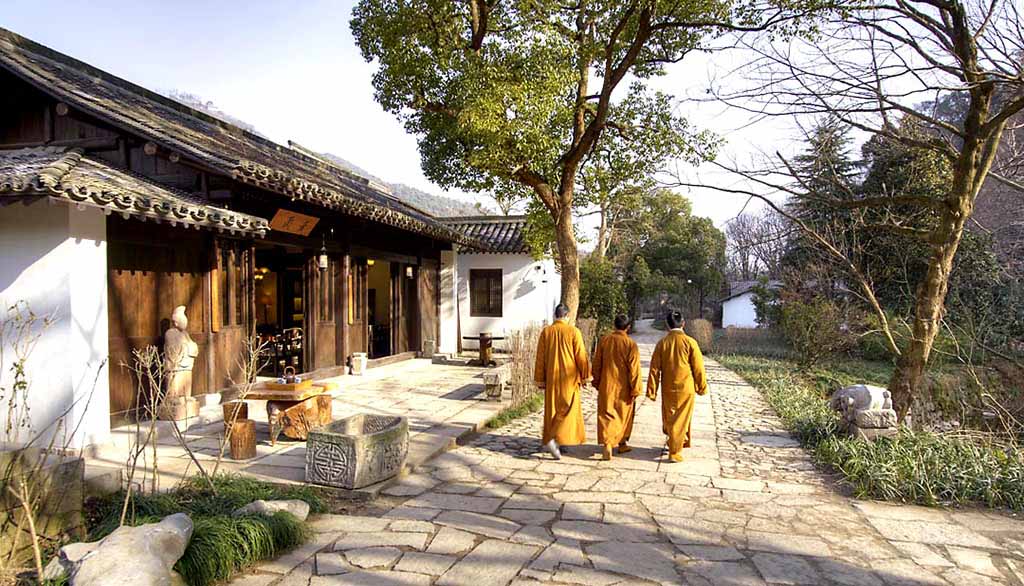
Indeed, Hangzhou is often described as “The Tea Capital of China” for its excellence in tea cultivation, and the hills surrounding West Lake produce the famous Longjing Tea. We'll visit the National Tea Museum in Longjing Village, the perfect place to learn about tea and its important place in China’s history. There’s also a nice tea house in the museum grounds where we can sample different varieties. At the teahouse at Dragon Well Village, we will also learn about and sample the different varieties of tea which is said to have all manner of healing powers, from improving your eyesight to curing heart conditions to helping you lose weight. The finest is the spring harvest tea (a great vintage can fetch $110 to $275 per pound). The tea at Dragon Well Village is of a higher quality than what you can buy downtown, or in the United States, so this is the place to stock up. Interestingly enough, the Hangzhou way to drink tea is to “eat” it, leaves and all.
After, exploring Hangzhou’s Old Town and the former residence of Hu Xueyan, a wealthy Qing dynasty businessman. The magnificent courtyard garden comes complete with a lake, pavilions, a zigzag bridge, red carp, and tri-lingual parrots. After, pausing for lunch in the Old Town at Huang Fan Er, “Emperor’s Kitchen” (order the dongpo pork, a 900-year-old Hangzhou specialty).
A short stroll after lunch will bring us to the museum that Hu Xueyan founded in 1874, the Hu Qing Yu Tang Museum of Traditional Chinese Medicine, where hundreds of medicinal plant and animal specimens are displayed, including bugs, snakes, and sea creatures (It’s a good thing you already ate). Here discover the old-world workshops where elderly pharmacists (called masters) demonstrate how they make herbal potions. Last comes the museum’s highlight: the pharmacy, where more white-coated masters scurry around filling herbal-medicine prescriptions, measuring and mixing all manner of strong-scented ingredients. After the drugstore, visiting the Xiling Seal Engravers’ Society on Solitary Hill, a museum in a lovely location on a West Lake islet that is devoted to two of China’s indelible cultural traditions: calligraphy, which is not just a way of writing but a beloved art form; and the chop— or seal—a symbol of one’s identity and also an object of artistic appreciation.
Hangzhou has many pagodas and temples, but we'll only visit one other favorite aside from Lingying, Leifeng Pagoda, which has a magnificent view of West Lake and the city skyline from the top. It’s not the original pagoda built in 975 AD—that collapsed in 1924 and was rebuilt in 2002—but it is so full of history and myths that one feels the past. Some parts of the original crumbling foundations are viewable, and some treasures discovered in an underground chamber.
In the afternoon, return to freshen up before dinner cruise (or by preference dining at a local restaurant). This pleasant cruise is on the lake to the Xixi wetlands, a water network of thousands of ponds, streams, and rivers, enjoying the beauty and romance of the Xixi Wetlands while a fascinating dinner is served in courses by your chef on your private boat.
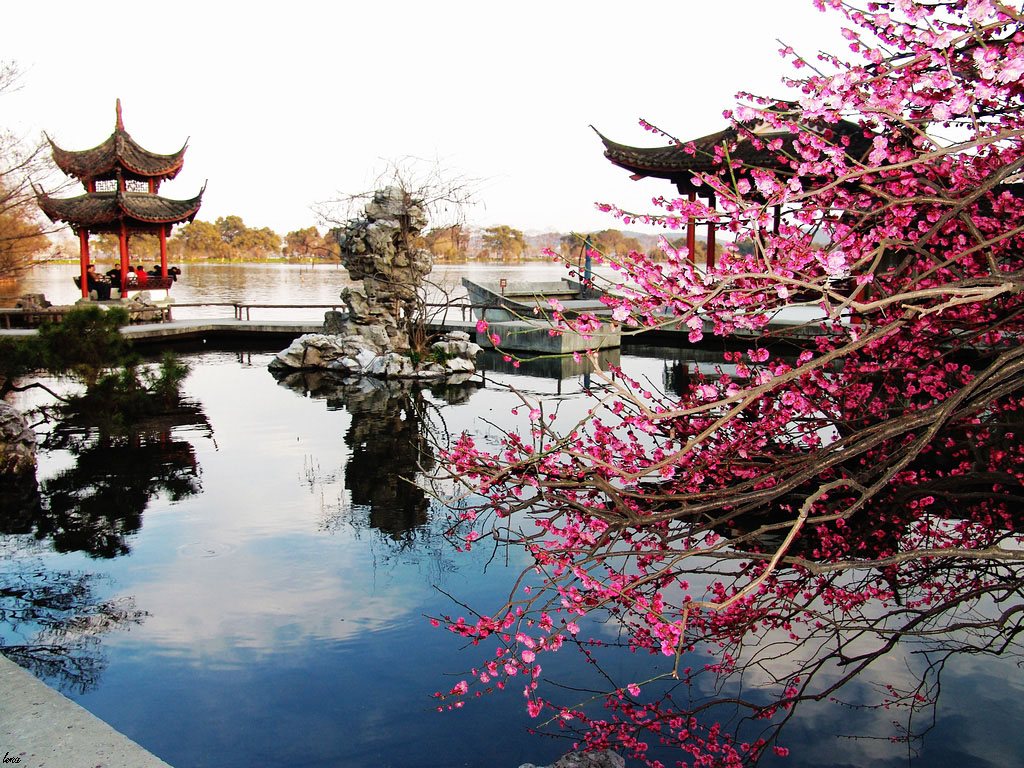
Given its location just 75 miles southwest of Shanghai, Hangzhou remains a place where the old and the new Chinas currently strive to coexist. Hangzhou has always been a prosperous city, thanks to its location at the southern end of the 1,100- mile-long Grand Canal and a terminus of the Silk Road, linking classical China with the ports of the eastern Mediterranean.
These days, however, the city enjoys a reputation as the most affluent in the entire country, where the newly wealthy of Shanghai buy hillside properties overlooking the bucolic West Lake, a combination of mountains and water which, like The Peak in Hong Kong, is said to possess especially potent feng shui, or mysteriously auspicious power. Hangzhou now possesses a population of more than six million, but despite its growing size, districts bordering the lake remain pretty, tranquil and clean. It is possible to walk, jog or cycle around much of the shoreline, pausing on the willow-shaded paths to gaze out across the expanse of glassy water. Aside from the lake, Hangzhou offers a number of fascinating monuments including the enormous 4th-century Lingyin Si Buddhist temple and the magnificent 10th-century Six Harmonies Pagoda.
After arrival by the futuristic high-speed mag-lev train to Hangzhou (45 minutes), touring Lingying Temple (灵隐寺 "Soul's Retreat"), believed to be the oldest Buddhist temple in Hangzhou. The temple has gone through numerous cycles of destruction and reconstruction, but remains a picturesque monastery that is the largest of several temples in the Wulin Mountains. Here are a large number of interesting grottoes and religious rock carvings, the most famous of which is the Feilai Feng (飞来峰; literally "the peak that flew hither"). The temple complex is a popular pilgrimage spot, the crowds are also interesting: a line of crimson- robed Tibetan nuns here, a cluster of chanting monks there. The Great Hall houses a most striking Buddha, China’s largest, at 81 feet tall, gilded and planted on a giant lotus.
Hangzhou's Lingying temple may provide a deeper understanding the importance of Buddhism in Chinese culture, but here it’s equally critical to steep yourself in the significance of tea. Hangzhou is the source of China’s finest green tea: Dragon Well, named after a serene spring situated amid the tea plantations just outside the city. Indeed, Hangzhou is often described as “The Tea Capital of China” for its excellence in tea cultivation, and the hills surrounding West Lake produce the famous Longjing Tea.
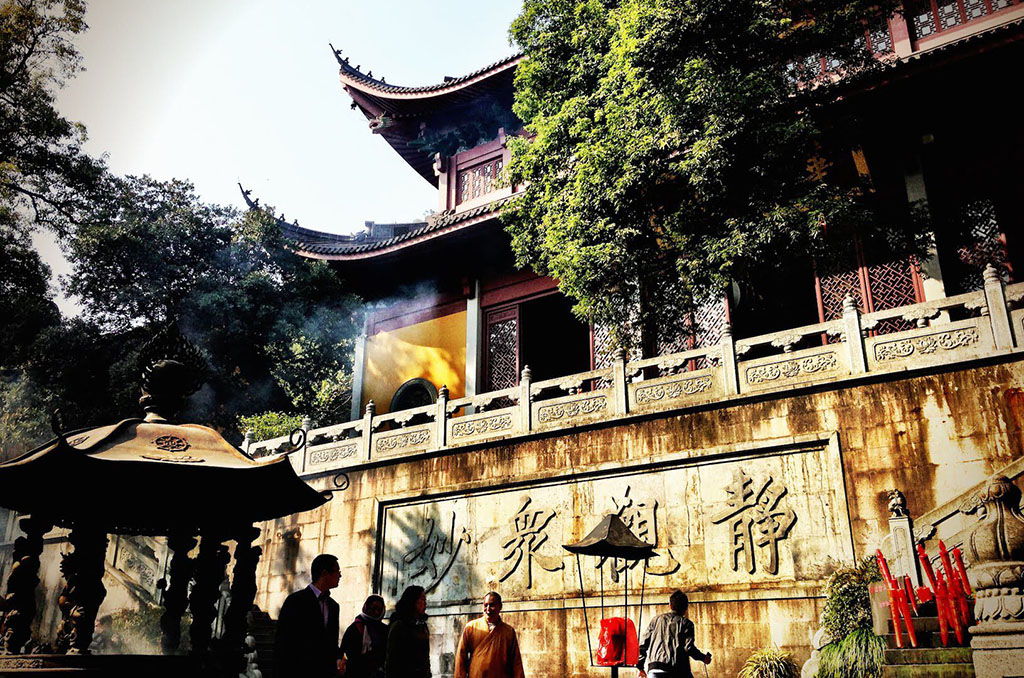
At the National Tea Museum in Longjing Village is a great place to learn about tea and its important place in China’s history. There’s also a pleasant tea house in the museum grounds and a traditional tea ceremony can be arranged by preference. At the teahouse at Dragon Well Village, one may also learn about and sample the different varieties of tea which is said to have all manner of healing powers, from improving your eyesight to curing heart conditions to helping you lose weight. The finest is the spring harvest tea; a great vintage can fetch $1-300 per pound, but of a higher quality than what you can buy in the U.S., so this is the place to stock up. Interestingly enough, the Hangzhou way to drink tea is to “eat” it, leaves and all.
After tea, exploring Hangzhou’s Old Town and the former residence of Hu Xueyan, a wealthy Qing dynasty businessman. The magnificent courtyard garden is replete with its own lake, pavilions, a zigzag bridge, red carp, and tri-lingual parrots. After, dining on Hangzhou specialties (see below).
A short stroll after lunch to the museum that Hu Xueyan founded in 1874, the Hu Qing Yu Tang Museum of Traditional Chinese Medicine, where hundreds of medicinal plant and animal specimens are displayed, including bugs, snakes, and sea creatures (It’s a good thing you already ate). Here we may discover the old-world workshops where elderly pharmacists (called masters) demonstrate how they make herbal potions. Last comes the museum’s highlight: the pharmacy, where more white-coated masters scurry around filling herbal-medicine prescriptions, measuring and mixing all manner of strong-scented ingredients.
After the drugstore, visiting the Xiling Seal Engravers’ Society on Solitary Hill, a museum in a lovely location on a West Lake islet that is devoted to two of China’s indelible cultural traditions: calligraphy, which is not just a way of writing but a beloved art form; and the chop— or seal—a symbol of one’s identity and also an object of artistic appreciation.
To cap this visit to Hangzhou, embarking on a pleasant cruise on the lake, enjoying the beauty and romance of the peaceful setting. After docking, return to Shanghai by high-speed train with your guide.
Hangzhou Highlights
Given how important gardens are to Chinese culture, the Botanical Gardens does not disappoint—and is the place that best shows off the greenery and flowers for which Hangzhou is famous, especially in the photo-perfect late-afternoon light.
Hu Xueyan's former residence and Hu Qing Yu Tang Museum of Traditional Chinese Medicine. Hu Xueyan was a wealthy Qing dynasty merchant whose former residence is a jewel of a mansion, painting a beautiful portrait of nineteenth-century life. He also founded a nearby museum where a highlight are the old-world workshops where elderly pharmacists (called masters) demonstrate how they make herbal potions and the pharmacy, where more white-coated masters scurry around filling herbal-medicine prescriptions, measuring and mixing all manner of strong-scented ingredients.
Anxious to burn off some energy? The lake is a perfect setting for biking, and we can take a spin around the lake stopping at points of interest. The lake is also ideal for an early morning jog.
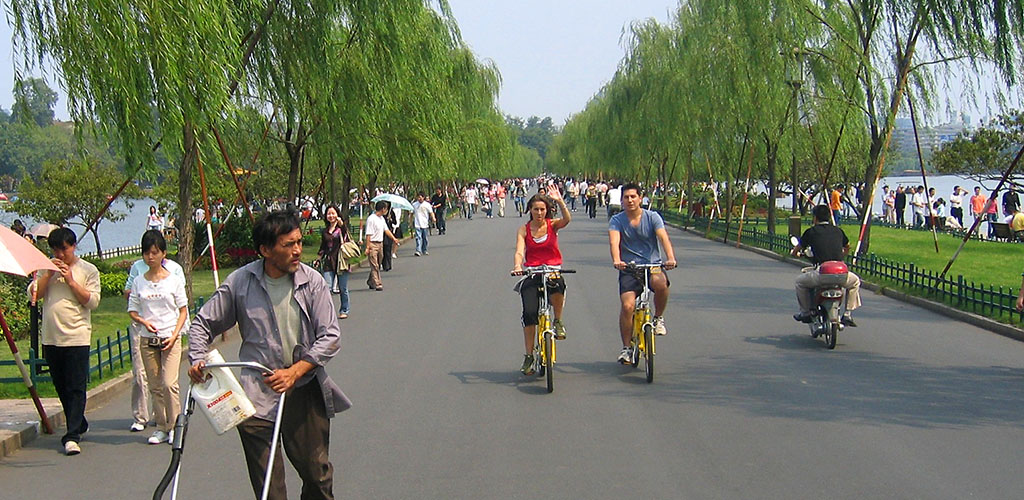
The Wetland Museum is a contemporary, almost futuristic, building which tells the history of the wetlands and its complex, fragile environment. There are many exhibits and a UFO-like observation tower. The park also has other attractions, such as Plum Villa, Autumn Snow Temple, Yanshui Fishing Villa, and Xixi Family House, which tell of the history and culture of the Hangzhou region.
Some of the best quality silk in China is sold on Hangzhou’s Silk Street. In earlier times, Chinese people would travel to Hangzhou to purchase silk sheets as gifts for newly married couples. That tradition continues today in many of the shops, but you can also find the most beautiful silk scarves, and swathes of quality silk for clothes. Don’t forget to bargain, it’s expected here. There is also the China Silk Museum (73-1 Yuhuangshan Rd.; 86-571-8703-5223), the world’s largest, which covers the history of silk and has a nifty gift shop, or the Hangzhou Silk Shopping Center, China’s biggest silk department store, which sells everything from silk umbrellas to silk hand cream and has a first-floor factory where you can see, step by step, how silkworms become duvets.
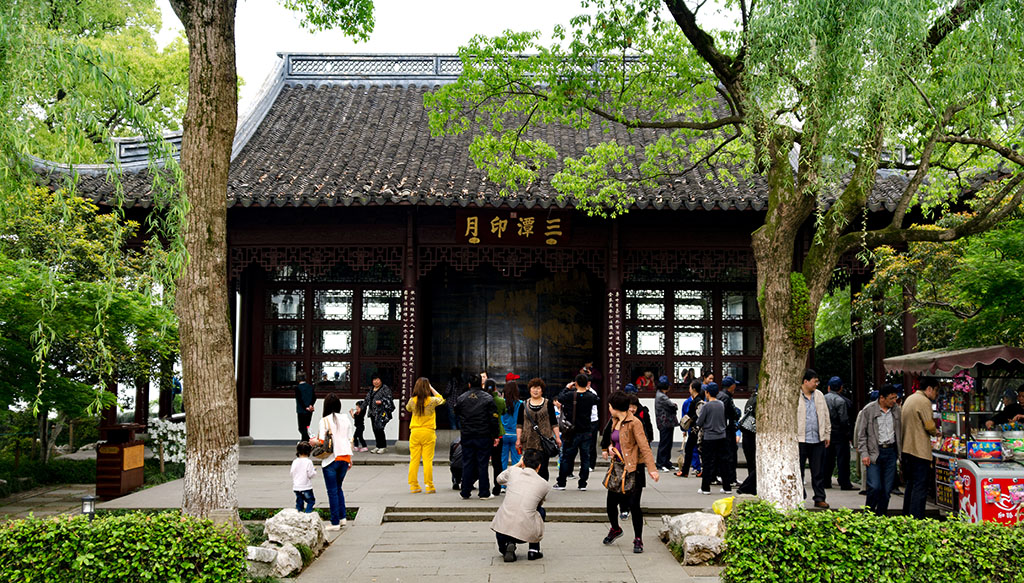
For last-minute shopping after dinner, there is the night market on Wushan. Of course the curios aren’t authentic, but the social scene is engaging.
Hangzhou Tea & Tea Plantations
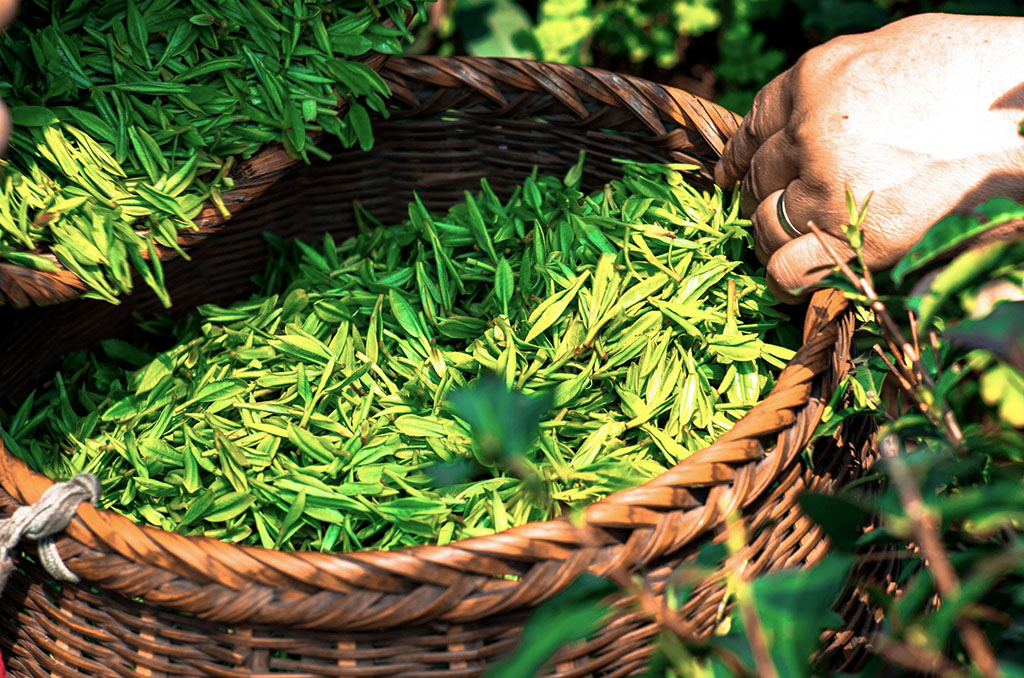
Hangzhou and tea, one of China's most important traditions, are synonomous. Famed for its high-quality tea, called Longjing ("Dragonwell"), some part of your visit to Hangzhou should involve learning about and experiencing the customs of tea. The area's highly-prized tea is a product of the ideal temperate, overcast and rainy winter climate of Hangzhou, that is said to contribute to the tenderness and sweetness of the buds and leaves. The tea leaves are picked early in the Spring and are then expertly pan-fried in a wok which further brings out the tea's unique characteristics, with slight sweet and bitter subtleties and the distinguished 'roasted chestnut' aroma. The tea is then tightly compressed, packaged and often stored for decades, or even centuries. The aged tea, similar to fine wine, is rarely consumed, but rather traded like fine art and increasing in value over time.
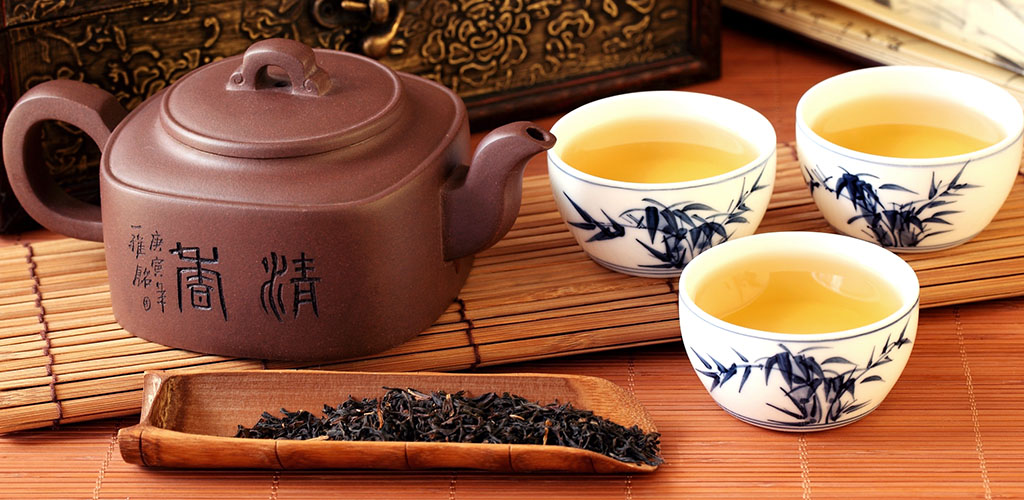
We may arrange a tea ceremony at a traditional tea house, or to even visit plantations and villages that produce tea in the area. During your visit, experience a tea ceremony at one of the country's most exclusive teahouses, such as Hu Pan Ju (Lakeside Teahouse), situated upon the banks of West Lake, with terrific views of the lake, enjoyed whiled sampling selections of the area's finest teas.

Dining
Family pleasing Grandma's Home is a popular chain in China and the Hangzhou Mansion is also busy, often with a wait (but less so for lunch). Try their modern take on Hangzhou Beggar’s Chicken.
Lou Wai Lou (reservation in advance for the main dining room, as private rooms do not have lake-view tables) is Hangzhou’s oldest restaurant, located at 3 Gushan Rd, is on the same islet as the Seal Engravers’ Society. Dine the main dining room (the private rooms do not have lake view tables). Two recommended Hangzhou specialties: beggar’s chicken, baked in lotus leaves and clay, and shrimp bathed in Dragon Well tea.
Yee Chino, located on North Zhongshan Road, as much for the atmospheric decor as the food. The owners are restaurant interior designers, and have created a really romantic space with lots of private nooks decorated in rich red tones with comfy chairs, soft lights and music. The food is very good and served on beautiful dinnerware. The Kobe beef is authentic and delicious.
Sample delicious street food, like Xiao Long Bao and Chun Juan, along a traditional old street, Nan Song Yu Jie, during the evening. For finer dining, the Yee Chino Restaurant is popular for its well-designed Hangzhou cuisine as well as a cozy and eclectic interior which makes guests feel right at home in this city. The view from large plate glass windows offers great people-watching opportunities.
If staying overnight, enjoy dinner cruise on the lake to the Xixi wetlands, a water network of thousands of ponds, streams, and rivers, enjoying the beauty and romance of the Xixi Wetlands while dinner is served in courses by your chef on your private boat.
Accommodations in Hangzhou
The Four Seasons
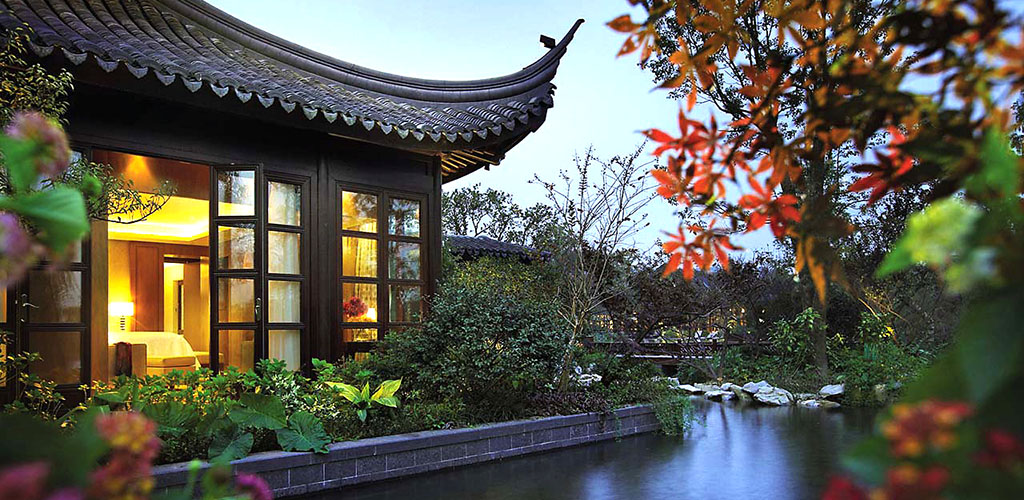
Ideally situated along the shores of beautiful West Lake, one of China's most picturesque ancient settings, the Four Seasons Hotel Hangzhou features serenity in a tranquil, natural enclave. Embraced by mist-shrouded peaks and peppered with weeping willows, lotus pools and painted pavilions, this area West Lake is rich in natural beauty.
Chinese gardens and bamboo groves are just steps from guest rooms. There is an outdoor pool, private spa suites, and 11 private dining pavilions surrounding the lagoon.
Amanfayun
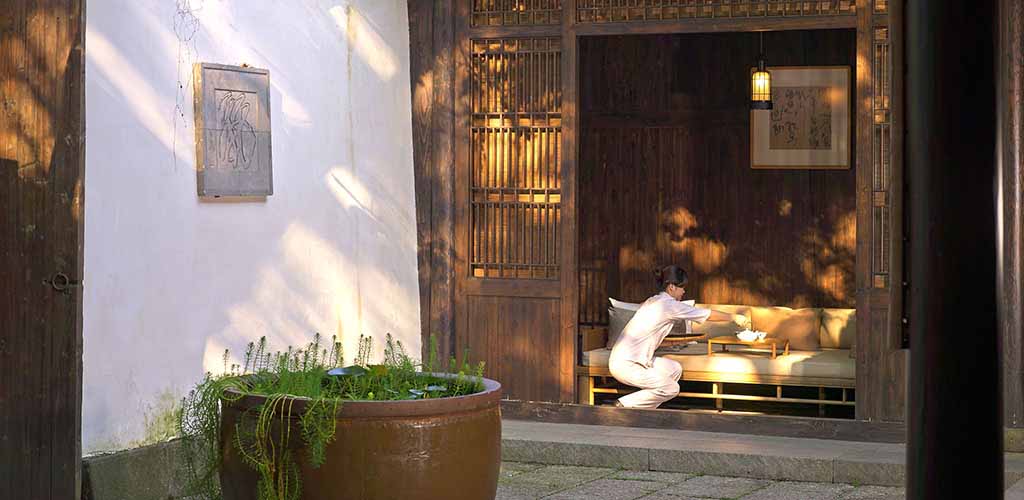
Created in to resemble a traditional Chinese village, Amanfayun is a place of ancient stone pathways leading to verdant courtyards, intimate restaurants and tranquil bungalows. Situated on 14 hectares near the West Lake, the resort is comprised of 47 dwellings that are surrounded by tea fields.
Contact us about planning your visit to Hangzhou, Shanghai, the nearby Yellow Mountains and historic Water Towns.
